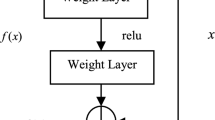Abstract
Recent improvements in marine science research have increased the importance of underwater fish species identification. Using technology to automate fish species identification would positively impact marine biology. Since deep learning techniques, image classification problems have become increasingly popular. Wild natural habitats make it harder to identify fish species because of the complex background and noise in the raw images. Some of the most advanced approaches for categorizing fish species in their natural habitats have been developed in the previous decade. This paper demonstrated an automated approach for classifying fish species based on deep residual networks. Existing transfer learning models do a good job working with smaller datasets, but not so effectively. A novel RESNET model (SmallerRESNET) is developed to reduce the overfitting generated by the standard pre-trained RESNET model. Convolutional and fully linked layers are used in the more straightforward form of the RESNET model. We evaluated and compared six different versions of the RESNET model. In addition to the number of convolutional and fully connected layers, the number of iterations required to achieve 80.56% accuracy on training data, batch size, and the dropout layer is examined. Compared to the original RESNET model, the proposed and modified RESNET model with fewer layers obtained 90.26% testing accuracy with a validation loss of 0.0916 on an untrained benchmark fish dataset. The inclusion of a dropout layer enhanced our proposed model's overall performance. It is more efficient with less memory, fewer training photos, and less computing complexity than its predecessor.
Access this chapter
Tax calculation will be finalised at checkout
Purchases are for personal use only
Similar content being viewed by others
References
Sudhakara, M., & Meena, M. J. (2021). Multi-scale fusion for underwater image enhancement using multi-layer perceptron. IAES International Journal of Artificial Intelligence, 10(2), 389.
Shu, L., Ludwig, A., & Peng, Z. (2021). Environmental DNA metabarcoding primers for freshwater fish detection and quantification: In silico and in tanks. Ecology and Evolution, 11(12), 8281–8294.
Shafait, F., Mian, A., Shortis, M., Ghanem, B., Culverhouse, P. F., Edgington, D., Cline, D., Ravanbakhsh, M., Seager, J., & Harvey, E. S. (2016). Fish identification from videos captured in uncontrolled underwater environments. ICES Journal of Marine Science, 73(10), 2737–2746.
Hernández-Serna, A., & Jiménez-Segura, L. F. (2014). Automatic identification of species with neural networks. PeerJ, 2, e563.
Hsiao, Y., Chen, C., Lin, S., & Lin, F. (2014). Real-world underwater fish recognition and identification using sparse representation. Ecological Informatics, 23, 13–21.
Jin, L., & Liang, H. (2017). Deep learning for underwater image recognition in small sample size situations. In OCEANS 2017-Aberdeen, 2017 (pp. 1–4).
Rudra Kumar, M., & Kumar Gunjan, V. (2020). Review of machine learning models for credit scoring analysis. Revista Ingeniería Solidaria, 16(1).
Rathi, D., Jain, S., & Indu, S. (2017). Underwater fish species classification using convolutional neural network and deep learning. In International Conference of Advances in Pattern Recognition.
Qin, H., Li, X., Liang, J., Peng, Y., & Zhang, C. (2016). Deepfish: Accurate underwater live fish recognition with a deep architecture. Neurocomputing, 187, 49–58.
Salman, A., Harvey, E., Jalal, A., Shafait, F., Mian, A., Shortis, M., & Seager, J. (2016). Fish species classification in unconstrained underwater environments based on deep learning. Limnology and Oceanography, Methods, 14, 570–585.
Moniruzzaman, M., Islam, S., Bennamoun, M., & Lavery, P. (2017). Deep learning on underwater marine object detection: A survey. In International Conference on Advanced Concepts for Intelligent Vision Systems (pp. 150–160).
He, K., Zhang, X., Ren, S., & Sun, J. (2016). Deep residual learning for image recognition. In Proceedings of the IEEE Conference on Computer Vision and Pattern Recognition (pp. 770–778). https://doi.org/10.1109/cvpr.2016.90
Zhang, X., Zhou, X., Lin, M., & Sun, J. (2018). Shufflenet: An extremely efficient convolutional neural network for mobile devices. In Conference on Computer Vision and Pattern Recognition (pp. 6848–6856).
Jäger, J., Simon, M., Denzler, J., Wolff, V., Fricke-Neuderth, K., & Kruschel, C. (2015). Croatian fish dataset: Fine-grained classification of fish species in their natural habitat. Swansea: Bmvc.
Author information
Authors and Affiliations
Corresponding author
Editor information
Editors and Affiliations
Rights and permissions
Copyright information
© 2023 The Author(s), under exclusive license to Springer Nature Singapore Pte Ltd.
About this paper
Cite this paper
Sudhakara, M., Vijaya Shambhavi, Y., Obulakonda Reddy, R., Badrinath, N., Reddy Madhavi, K. (2023). Fish Classification System Using Customized Deep Residual Neural Networks on Small-Scale Underwater Images. In: Rao, B.N.K., Balasubramanian, R., Wang, SJ., Nayak, R. (eds) Intelligent Computing and Applications. Smart Innovation, Systems and Technologies, vol 315. Springer, Singapore. https://doi.org/10.1007/978-981-19-4162-7_31
Download citation
DOI: https://doi.org/10.1007/978-981-19-4162-7_31
Published:
Publisher Name: Springer, Singapore
Print ISBN: 978-981-19-4161-0
Online ISBN: 978-981-19-4162-7
eBook Packages: Intelligent Technologies and RoboticsIntelligent Technologies and Robotics (R0)




